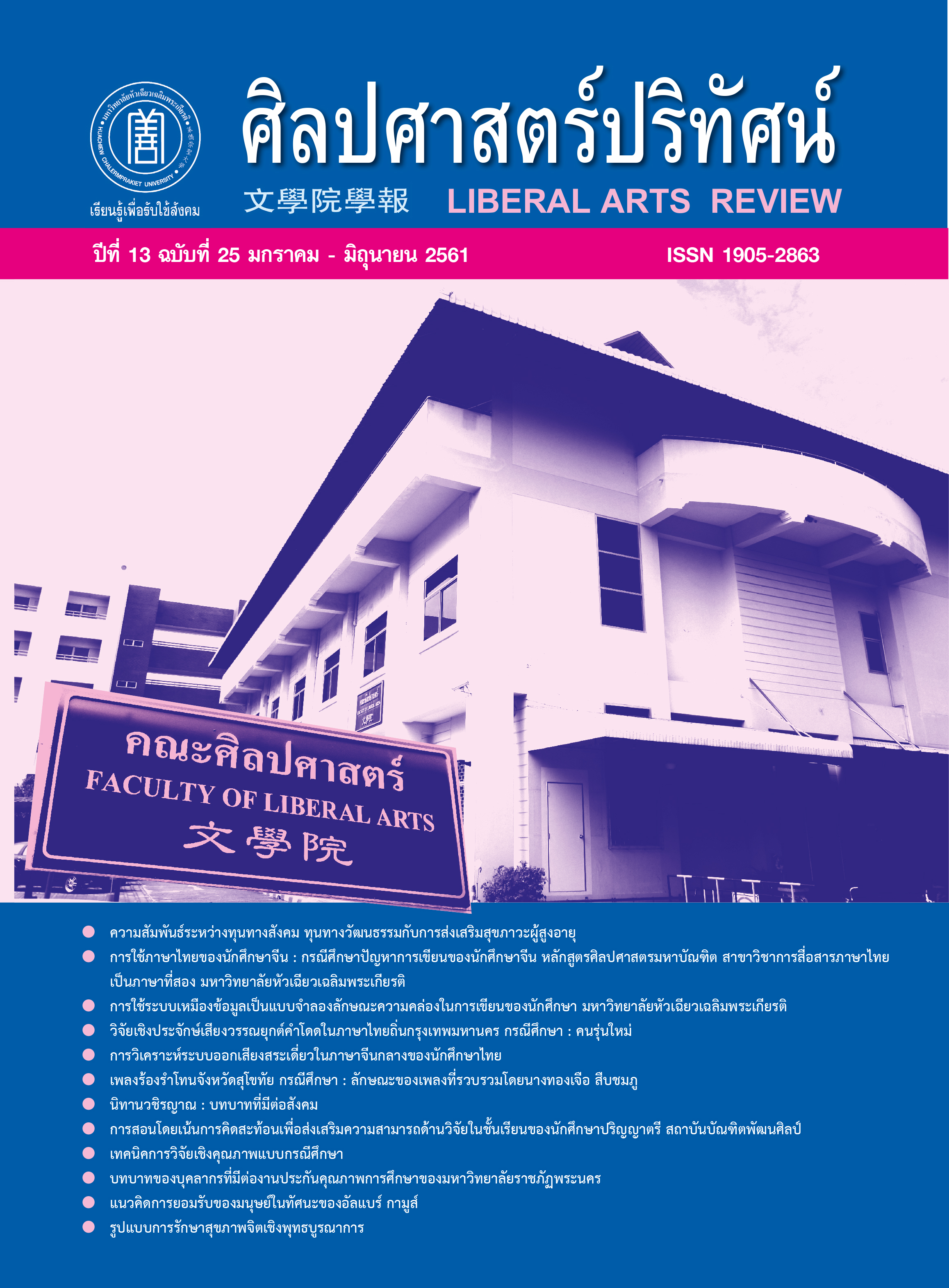เพลงร้องรำโทนจังหวัดสุโขทัย กรณีศึกษา: ลักษณะของเพลง ที่รวบรวมโดยนางทองเจือ สืบชมภู
บทคัดย่อ
การวิจัยเรื่องเพลงร้องรำาโทนจังหวัดสุโขทัย กรณีศึกษา ลักษณะของเพลงที่รวบรวมโดยนาง ทองเจือ สืบชมภู เป็นการวิจัยเชิงคุณภาพ มีวัตถุประสงค์เพื่อ (1) ศึกษาประวัติความเป็นมาของรำาโทน จังหวัดสุโขทัย (2) ศึกษาลักษณะของเพลงร้องรำโทนที่รวบรวมโดยนางทองเจือ สืบชมภู ซึ่งรวบรวม ข้อมูลโดยใช้แบบสัมภาษณ์และแบบสังเกต นำมาวิเคราะห์โดยใช้ทฤษฎีของรูท เบนิดิกต์ วิเคราะห์ วัฒนธรรมและพฤติกรรมของคนไทย ใช้แนวคิดของจอร์จ ลิสท์ วิเคราะห์ลักษณะของเพลงดนตรีพื้นบ้าน
จากการศึกษาพบว่า รำโทนของจังหวัดสุโขทัยมีมาก่อนสงครามโลกครั้งที่ 2 เรียกว่า รำวง แต่ไม่เป็นที่นิยมเล่นกันมากนัก จนมาในช่วงสงครามโลกครั้งที่ 2 จังหวัดสุโขทัยเป็นเส้นทางในการเดิน ทัพของทหารญี่ปุ่นเพื่อไปยังประเทศพม่า ทำให้ประชาชนเกิดความหวาดกลัว ดังนั้น จอมพล ป. พิบูล สงคราม นายกรัฐมนตรีในขณะนั้น จึงส่งเสริมให้ประชาชนเล่นรำาวง แต่เปลี่ยนชื่อเสียใหม่ว่ารำาโทน เครื่อง ดนตรีที่ใช้ในการเล่นรำาโทนประกอบด้วยโทนชาตรี ฉิ่ง ฉาบเล็ก กรับ เมื่อสงครามโลกครั้งที่ 2 สงบลง จึงพัฒนาเป็นรำาวงอาชีพ และใช้กลองทอมบ้าแทน
เพลงร้องรำโทนที่นางทองเจือ สืบชมพู ได้รวบรวมไว้นั้น มีทั้งหมด 103 เพลง จัดหมวดหมู่ได้ 6 หมวดหมู่ ได้แก่ เพลงเชิญชวน เพลงปลอบขวัญ เพลงชมโฉม/เกี้ยวพาราสี/ตัดพ้อ เพลงวรรณคดี/ชาดก เพลงเบ็ดเตล็ด และเพลงลา ซึ่งพบว่าบทร้องส่วนมาก อยู่ในหมวดหมู่เพลงชมโฉม/เกี้ยวพาราสี/ตัดพ้อ ลักษณะเพลงร้องรำาโทนจะเป็นเนื้อร้องสั้น ๆ ไม่มีสัมผัสที่แน่นอนตายตัวแบบกลอนแปด นำสิ่งที่พบเห็น เหตุการณ์ต่าง ๆ มาแต่งเป็นเนื้อร้อง ใช้เนื้อร้องของเพลงในวรรคแรกมาเรียกเป็นชื่อเพลง มีเนื้อหาสุภาพ การร้องจะร้องวนไปมา โดยผู้ที่เป็นต้นเสียงจะเป็นผู้ที่ทำหน้าที่ขึ้นเพลง การร้องจะเริ่มต้น ด้วยเพลง เชิญชวนและจบด้วยเพลงลา
ดาวน์โหลด
เผยแพร่แล้ว
รูปแบบการอ้างอิง
ฉบับ
ประเภทบทความ
สัญญาอนุญาต
บทความที่ได้รับการตีพิมพ์เป็นลิขสิทธิ์ของวารสารศิลปศาสตร์ปริทัศน์
ข้อความที่ปรากฏในบทความแต่ละเรื่องในวารสารวิชาการเล่มนี้เป็นความคิดเห็นส่วนตัวของผู้เขียนแต่ละท่านไม่เกี่ยวข้องกับมหาวิทยาลัยหัวเฉียวเฉลิมพระเกียรติ และคณาจารย์ท่านอื่นๆในมหาวิทยาลัยฯ แต่อย่างใด ความรับผิดชอบองค์ประกอบทั้งหมดของบทความแต่ละเรื่องเป็นของผู้เขียนแต่ละท่าน หากมีความผิดพลาดใดๆ ผู้เขียนแต่ละท่านจะรับผิดชอบบทความของตนเองแต่ผู้เดียว




